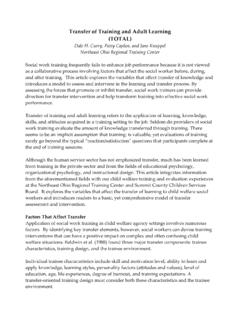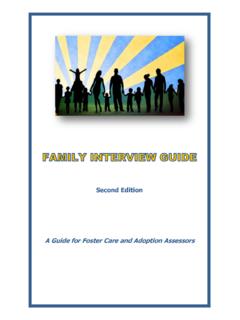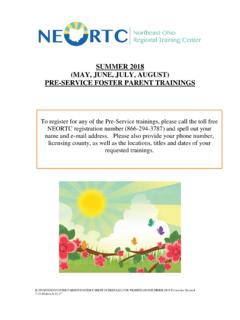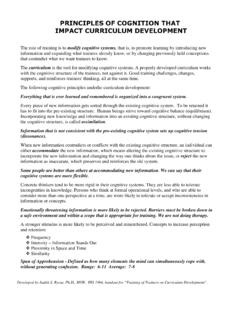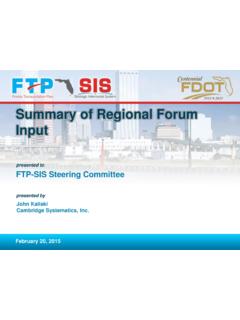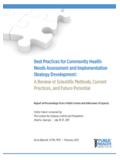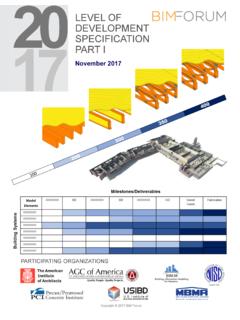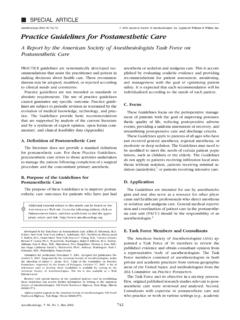Transcription of A FORUM FOR IDEAS, OPINIONS, INNOVATIONS
1 If you answered yes to the above questions, then read Ruth C. Clark s newest sum-mary of current learning research: Evidence-Based Training Methods: A Guide for Training Professionals. A FORUM FOR IDEAS, OPINIONS, INNOVATIONSPROMOTING BESTPRACTICE SINCE 1986 ISSUE 46, OCTOBER 2010In this easy to read book, Clark dispels common training myths. Here is a highlight of six of our favorites:Myth: Assessing and accommodating learning styles increases : According to Clark, learning styles represent one of the more pervasive training myths of the past 20 years. The fact is that when learning something new, we are all visual learn-ers. When reviewing a complex visual we all benefit from an audio explanation rather than a detailed text explanation. Assessing a learner s prior knowledge of content rather than their learning style is more effective.
2 For example, novices benefit from visuals, but visuals do little for those with experience. Myth: Using the latest technology solves all learning dilemmas. (Clark refers to this as the pana-cea of technology.)Fact: The active ingredients of your training are what cause learning regardless of the media used. Clark encourages trainers to, Ignore panaceas in the guise of technology solutions in favor of applying proven practices on best use of instructional modes and methods to all media you use to deliver training. (p. 14)EVIDENCE-BASEDTRAINING METHODS When you go to a doctor, you expect her to be well-informed, versed in the latest medical research and current best practices. As training professionals, our customers expect and deserve the same. Ruth Clark gives practitioners the tools to design training based on proven, evidence-based practices rather than guesswork and conjectures.
3 Frank Nguyen, Emerging Technologies Manager, American Express Want to learn how to .. Use visuals and words to maximize learning? Avoid death by PowerPoint? Design your learning to maximize the training day?2 Myth: The more they like it, the more they learn. Fact: The correlation between satisfaction scores and learning are too small to be reliable. This is why the OCWTP evaluation forms have changed over the years from purely satisfac-tion ratings to assessing knowledge gained and asking learners how the training will impact their : Content covered is content learned. Fact: Unfortunately, this is not true. You might be able to plow through content in the time al-lotted by eliminating time consuming application exercise, but for many of the complex skills required by child welfare staff and caregivers it is the practice that helps translate knowledge into skill.
4 Myth: Practice always increases : There are some caveats to this notion. Research indicates that practice needs to be carefully constructed and timed to be effective. The biggest skill gain accrues in the first few practices. Continued practice can result in diminished return. For better long-term learning, practice should be dispersed throughout the learning event not held off to the last segment after all content is taught. Learning is maximized when practice questions or assignments blend several different topics that require the learner to use critical thinking skills. Research continues to support the fact that the closer to the real work experience, the better the : Practice is all that s needed to build : Trainers can improve learning by replacing some practice exercises with examples.
5 Clark states, In training designed to build skills, examples are not only useful--they are essential! (p. 148) In her book, Clark sites studies that indicate that combining practice with examples of problems already worked out can accelerate learning. Most of our training designs include practice but many fail to include examples. Providing a handout of an effective case plan and then asking participants to practice creating their own is one example of combining both ap-proaches. Another effective combination is to have the trainer model the skill before partici-pants practice with role has been learned in the past 20 years about effective training methodologies and there is a growing body of research for the training field. However, many trainers still use time-honored methods and assume they work, despite recent evidence to the contrary.
6 The above only skims a small part of what Clark s book offers trainers. It has been recommended by several training and instructional design experts as a must read for 2010, and we heartily :Clark, Ruth C., (2010), Evidence-Based Training Methods: A Guide for Training Professionals, Alexandria, VA: ASTD Trainer Nancy Burley, LISW-S, was selected as a 2010 Angel in Adoption recipient for her out-standing adoption advocacy and years of contribution to the field. The Congressional Coalition on Adop-tion Institute (CCAI), which orchestrates the Angels in Adoption program, honored her along with more than 190 Angels, at an awards ceremony and gala event in Washington, DC, on October 6, 2010. As Executive Director and founding member of Adop-tion Circle, Ms. Burley has contributed to the agency becoming one of the leading adoption agencies in Ohio.
7 She is highly regarded by birthparents, adop-tive families, adoption professionals, social workers, attorneys, and judges for her expertise, dedication, and determination in the field of adoption. She never ceases to present adoption and all of its benefits in the most positive manner. The Angels in Adoption program is CCAI s signature public awareness campaign and provides an opportu-nity for all members of the Congress to honor the good work of their constituents who have enriched the lives of foster children and orphans in the United States and abroad. Former National Angels include First Lady Laura Bush, Patti LaBelle, Jane Seymour, Muhammad Ali, the late Dave Thomas, Steven Curtis Chapman, Bruce Willis, Alonzo Mourning, and Marcus CCAI is a 501(c) 3 nonpartisan organization dedicated to raising awareness about the tens of thousands of orphans and foster children in the United States and the millions of orphans around the world in need of permanent, safe, and loving homes through adoption.
8 CCAI s goal is the elimination of the barriers that hinder these children from realizing their basic right of a family. For more information on the Angel in Adoption program, visit National Staff Development and Training Association (NSDTA) presented its awards on August 31, 2010, at NSDTA s Annual Professional Development Institute in Boston. Betsy Keefer Smalley received the Career Achievement Award for her devotion to promoting permanency for abused and ne-glected children, and her pioneering of training as a primary means to move the adoption and foster care systems towards placement stability. She has consistently provided high quality training, curriculum development, and leadership in the field of public human services for over 40 years. As Director of the adoption and foster care training component at the Institute for Human Services, through the Ohio Child Welfare Training Program, Ms.
9 Keefer Smalley works with a large constituency of regional training managers, county agency directors, the Ohio Department of Job and Familiy Services, and a large pool of adoption and foster care Still-Pepper, trainer for the OCWTP, received the Dis-tinguished Service in Training Award. This award is given to individuals demonstrating outstanding skills as an adult educa-tor in public human services by using creative approaches and ensuring that effective transfer of learning occurs. Mr. Still-Pepper has written and presented his innovative training curricula to child welfare caseworkers, supervisors, and foster parents. For more information on the NSDTA Awards, visit: our profession:APPLAUSE AND RECOGNITIONB etsy Keefer Smalley Jim Still-Pepper Receive NSDTA AwardsNancy Burley Honored by Senator George Voinovich4If you had asked me in 2004, after aging out of foster care, if in the future, I would ever be back on the professional side of child welfare, I would have laughed or said, I highly doubt it.
10 But here we are in 2010 and I am pleased to be a part of the OCWTP family. Our child welfare system has changed a great deal since the 11 combined years I spent in care. However, there is one aspect that remains the same - the lack of youth input into their lives and their future as it relates to being in care. During my tenure in care, there were numerous opportunities to involve me in my case and to bring my eyes, my ears, and my insights to the table. However, the opportunities weren t seized. I was not allowed to go to my court hearings, I was not invited to the table, nor was I informed of the status or progression of my case unless I was being placed in another home. These missed opportuni-ties left me feeling empty and fearful of the unknown - feelings I still struggle with today.
